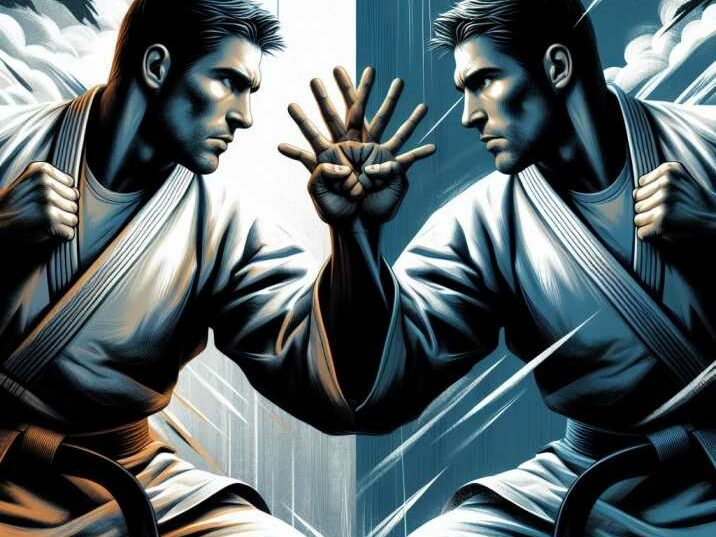Introduction:
Table of Contents
In the world of martial arts, two main approaches dominate the landscape: defensive and offensive styles. While both are rooted in the principles of self-defense and discipline, they diverge significantly in their techniques, philosophies, and applications. In this guide, we’ll delve deep into the contrasts between defensive vs offensive martial arts, providing insights, tips, and facts to help you understand and navigate these distinct paths.

Table of Contents:
- Introduction
- Understanding Defensive Martial Arts
- Exploring Offensive Martial Arts
- Techniques and Strategies
- Mental and Emotional Aspects
- Choosing the Right Path
- Conclusion
- Image Placement and Optimization
- Frequently Asked Questions (FAQs)
1. Understanding Defensive Martial Arts
- Defensive martial arts prioritize evading and deflecting attacks over initiating them. Styles like Aikido, Judo, and Wing Chun emphasize redirecting an opponent’s force rather than meeting it head-on. These arts often focus on leveraging an opponent’s momentum against them, promoting efficiency and conserving energy.
- Tip: Practice techniques that emphasize footwork and body positioning to maintain distance and control during confrontations. Utilize joint locks and throws to neutralize opponents without inflicting harm.
2. Exploring Offensive Martial Arts
- Offensive martial arts, on the other hand, emphasize aggression and assertiveness, aiming to incapacitate or subdue opponents quickly. Arts such as Muay Thai, Boxing, and Taekwondo prioritize striking techniques like punches, kicks, and knees to overwhelm adversaries with force.
- Tip: Develop speed, power, and precision through repetitive drills and sparring sessions. Focus on conditioning exercises to enhance endurance and resilience during high-intensity engagements.
3. Techniques and Strategies for Defensive vs Offensive Martial Arts
- Defensive techniques often involve circular movements, redirection, and leverage, enabling practitioners to control and neutralize attackers efficiently. Joint locks, throws, and grappling maneuvers are common in defensive arts, emphasizing control and restraint.
- Offensive techniques revolve around direct, linear strikes aimed at inflicting maximum damage in minimal time. Practitioners hone their striking accuracy, power, and speed to overwhelm opponents with a barrage of attacks, exploiting openings and vulnerabilities.
- Tip: Master a diverse range of techniques from both defensive and offensive disciplines to become a well-rounded martial artist capable of adapting to various situations and opponents.
4. Mental and Emotional Aspects
- Defensive martial arts often emphasize calmness, awareness, and adaptability, teaching practitioners to remain composed under pressure and assess threats effectively. These arts cultivate a mindset focused on self-control, humility, and conflict resolution.
- Offensive martial arts promote confidence, assertiveness, and determination, encouraging practitioners to assert their dominance and overcome challenges with unwavering resolve. Mental toughness, aggression, and competitive spirit are key pillars of offensive training.
- Tip: Cultivate mental resilience and emotional intelligence through meditation, visualization, and mindfulness practices. Develop a balanced mindset that combines the strengths of both defensive and offensive philosophies.
5. Choosing the Right Path
- When selecting a martial art to pursue, consider your personal goals, preferences, and temperament. If you prioritize self-defense, discipline, and harmony, a defensive art like Aikido or Judo may suit you best. If you seek physical fitness, aggression, and competition, an offensive art like Boxing or Muay Thai might be more appealing.
- Evaluate the availability of reputable instructors, training facilities, and community support when choosing a martial arts school. Attend introductory classes, observe training sessions, and consult with experienced practitioners to gain insights into the style’s suitability for your needs.
- Tip: Experiment with different martial arts styles and instructors to find the right fit for your goals and personality. Remember that martial arts is a lifelong journey of learning and self-discovery, so stay open-minded and committed to continuous improvement.
Conclusion:
In conclusion, the choice between defensive and offensive martial arts ultimately boils down to personal preference, goals, and temperament. Whether you opt for the circular movements of Aikido or the explosive strikes of Muay Thai, both paths offer valuable insights, skills, and experiences that can enrich your life on and off the mat. By understanding the nuances between defensive and offensive styles, you can embark on a martial arts journey that aligns with your aspirations and empowers you to navigate life’s challenges with confidence and resilience.
Frequently Asked Questions (FAQs):
- Q: Which is better for self-defense, defensive or offensive martial arts?
- A: It depends on personal preference and situational context. Defensive arts focus on evasion and redirection, while offensive arts prioritize aggression and force.
- Q: Can I practice both defensive and offensive martial arts simultaneously?
- A: Absolutely! Many practitioners incorporate elements from both styles to develop a well-rounded skill set and adaptability in diverse scenarios.
- Q: Are defensive martial arts less effective in competitive settings?
- A: Not necessarily. While defensive arts may appear less aggressive, they can be highly effective in competitions that emphasize technique, strategy, and control.
- Q: Do I need prior experience to start training in defensive or offensive martial arts?
- A: No, most martial arts schools welcome beginners of all levels. Start with introductory classes to learn the basics and gradually progress at your own pace.
- Q: How can I find a reputable martial arts instructor or school near me?
- A: Research online reviews, visit local martial arts academies, and talk to current students or instructors to assess the quality of instruction and the atmosphere of the school.


